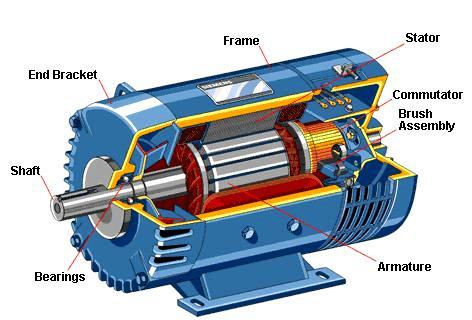PSC Motors (Permanent Split Capacitor Motors):
One kind of AC single-phase induction motor is the PSC motor. A main winding and an auxiliary winding are both included in these, with the latter being linked in series with a capacitor. This capacitor aids the motor’s operation by providing extra torque during startup. When compared to single-phase motors, PSC motors perform better because they mimic two-phase operation by engaging both windings concurrently.
PSC motors have a reputation for being dependable and affordable. Their balanced performance and price make them common in HVAC systems for fans, pumps, and small compressors. Nevertheless, they may not provide the same degree of performance when it comes to controlling speed and torque compared to more modern technologies, such as ECM motors, and they use more energy.
ECM Motors (Electronically Commutated Motors):
The superior performance is a result of the sophisticated design of ECM motors, which are also called brushless DC motors. They transform alternating current (AC) into direct current (DC) with the use of an inverter. Instead of using brushes, which can wear out with time, the motor’s microcontroller electronically manages commutation. Thanks to this innovation, ECM motors can keep their speeds constant even when the load changes, which greatly improves their efficiency.
The strong torque across the speed range, silent operation, and small size are just a few of the benefits that ECM motors provide, despite their higher price tag. Due to its design, ECM motors are ideal for use in energy-efficient HVAC systems used in both commercial and residential buildings.
Split Phase Motors:
One type of single-phase AC induction motor is the split-phase motor, which has a main winding and a start winding. A centrifugal switch disengages the start winding after the motor achieves about 70-80% of its rated speed; it offers additional torque at startup. Once the motor reaches speed, its design enables it to run smoothly.
Despite its low price and excellent speed regulation, split-phase motors aren’t very efficient or have a lot of torque. Their modest torque capabilities make them ideal for low-performance applications, such as tiny fans and blowers, where cost-effectiveness and ease of use take precedence.
CSIR Motors (Capacitor-Start Induction-Run Motors):
A capacitor is used in the start winding of a CSIR motor, which increases torque, making it similar to a split-phase motor. CSIR motors can manage high-inertia loads more skillfully thanks to this extra component. You won’t need the start capacitor anymore after the motor gets up to operating speed, although it does help with startup performance.
For machines like pumps and compressors that need a lot of torque when starting, CSIR motors are the way to go. Although they perform better at startup, they are less efficient overall when running continuously than motors that use a run capacitor. Their affordability makes them a good fit for uses that need a lot of starting torque but don’t want to break the bank.
CSCR Motors (Capacitor Start Capacitor Run Motors):
With the addition of a start capacitor and a run capacitor, CSCR motors take the CSIR motor to the next level. Both startup and regular operation benefit from the improved performance brought forth by this dual-capacitor set-up. While the run capacitor increases efficiency when used continuously, the start capacitor helps with initial torque.
Because they use two capacitors, CSCR motors are more expensive, but they perform better. High-torque applications in industrial environments are a good fit for them since their performance justifies the extra cost. Because of its high efficiency and remarkable torque characteristics, CSCR motors are perfect for rigorous HVAC applications.
Variable Speed Motors:
In addition, variable speed motors, a completely new category of motor, have been introduced in the last several years. There was a time when you could only turn air conditioner motors on or off. When turned on, they would run continuously at full speed until the temperature was set, at which point they would stop power and return to zero. While this system was in operation, the temperature inside your home fluctuated, blasting frigid air for some time before allowing the air to warm up until the system was triggered again.
A variable-speed motor allows the system to gradually increase or decrease the amount of cool air it produces. Therefore, the system operates at modest speeds on days when minimal cooling is needed. These engines are fantastic for budget-friendly living since they prevent your home from being over-cooled. Furthermore, they are more resilient to wear and tear because of their ability to adapt to the specific demands of their surroundings.
FAQs:
· If The Blower Motor Starts But Not Enough Airflow Is Produced, What Should I Do?
Check the air filter to make sure it is clean and not blocking airflow if the blower motor functions but the vents do not provide enough airflow. Check the blower wheel for any accumulation of debris that might be obstructing airflow. The blower motor’s capacitor, bearings, or wiring may need to be inspected and repaired by an expert if these procedures are unable to fix the problem.
· Are There Noise-Reducing Options Available For Blower Motors In Air Conditioners?
Insulated cabinets and sound-dampening types of blower motors are indeed alternatives for lowering noise. When compared to conventional blower motors, ECM (Electronically Commutated Motor) motors are renowned for operating more quietly. By making the air conditioner run quieter, you can improve indoor comfort by switching to a quieter blower motor.
· How Do I Determine If My Blower Motor Needs Lubrication, And How Should It Be Done?
Certain blower motors—especially the older models—might need to be lubricated regularly. Grinding or squeaking sounds are indicators that a blower motor needs to be lubricated. To lubricate, identify the lubrication ports on the motor, turn off the HVAC system’s power, and lightly apply the required oil.


